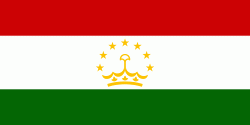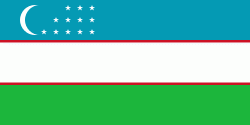Tajik language
Tajik (Tajik: Забони тоҷикӣ, Zaboni tojikī, ), also called Tajiki Persian (Tajik: форси́и тоҷикӣ́, forsii tojikī, ) or Tajiki, is the variety of Persian spoken in Tajikistan and Uzbekistan by Tajiks. The Madaklashti dialect of Tajik is also spoken in the Chitral District of Pakistan. It is closely related to neighbouring Dari with which it forms a continuum of mutually intelligible varieties of the Persian language. Several scholars consider Tajik as a dialectal variety of Persian rather than a language on its own. The popularity of this conception of Tajik as a variety of Persian was such that, during the period in which Tajik intellectuals were trying to establish Tajik as a language separate from Persian, prominent intellectual Sadriddin Ayni counterargued that Tajik was not a "bastardised dialect" of Persian. The issue of whether Tajik and Persian are to be considered two dialects of a single language or two discrete languages has political sides to it.
By way of Early New Persian, Tajik, like Iranian Persian and Dari Persian, is a continuation of Middle Persian, the official religious and literary language of the Sasanian Empire (224–651 CE), itself a continuation of Old Persian, the language of the Achaemenids (550–330 BC).
Tajik is one of the two official languages of Tajikistan, the other being Russian as the official interethnic language. In Afghanistan (where the Tajik minority forms the principal part of the wider Persophone population), this language is less influenced by Turkic languages, is regarded as a form of Dari, and as such, has co-official language status. The Tajik of Tajikistan has diverged from Persian as spoken in Afghanistan and Iran due to political borders, geographical isolation, the standardisation process and the influence of Russian and neighbouring Turkic languages. The standard language is based on the northwestern dialects of Tajik (region of the old major city of Samarqand), which have been somewhat influenced by the neighbouring Uzbek language as a result of geographical proximity. Tajik also retains numerous archaic elements in its vocabulary, pronunciation, and grammar that have been lost elsewhere in the Persophone world, in part due to its relative isolation in the mountains of Central Asia.
Up to and including the nineteenth century, speakers in Afghanistan and Central Asia had no separate name for the language and simply regarded themselves as speaking Farsi, which is the endonym for the Persian language. The term Tajik, derived from the Persian for "foreigner", was an exonym used by Turkic speakers to refer to Persian speakers (the word Tat has a similar origin), although it has been adopted by the speakers themselves.
In 1989, with the growth in Tajik nationalism, a law was enacted declaring Tajik the state (national) language, with Russian being the official language (as throughout the Union). In addition, the law officially equated Tajik with Persian, placing the word Farsi (the endonym for the Persian language) after Tajik. The law also called for a gradual reintroduction of the Perso-Arabic alphabet.
In 1999, the word Farsi was removed from the state language law.
By way of Early New Persian, Tajik, like Iranian Persian and Dari Persian, is a continuation of Middle Persian, the official religious and literary language of the Sasanian Empire (224–651 CE), itself a continuation of Old Persian, the language of the Achaemenids (550–330 BC).
Tajik is one of the two official languages of Tajikistan, the other being Russian as the official interethnic language. In Afghanistan (where the Tajik minority forms the principal part of the wider Persophone population), this language is less influenced by Turkic languages, is regarded as a form of Dari, and as such, has co-official language status. The Tajik of Tajikistan has diverged from Persian as spoken in Afghanistan and Iran due to political borders, geographical isolation, the standardisation process and the influence of Russian and neighbouring Turkic languages. The standard language is based on the northwestern dialects of Tajik (region of the old major city of Samarqand), which have been somewhat influenced by the neighbouring Uzbek language as a result of geographical proximity. Tajik also retains numerous archaic elements in its vocabulary, pronunciation, and grammar that have been lost elsewhere in the Persophone world, in part due to its relative isolation in the mountains of Central Asia.
Up to and including the nineteenth century, speakers in Afghanistan and Central Asia had no separate name for the language and simply regarded themselves as speaking Farsi, which is the endonym for the Persian language. The term Tajik, derived from the Persian for "foreigner", was an exonym used by Turkic speakers to refer to Persian speakers (the word Tat has a similar origin), although it has been adopted by the speakers themselves.
In 1989, with the growth in Tajik nationalism, a law was enacted declaring Tajik the state (national) language, with Russian being the official language (as throughout the Union). In addition, the law officially equated Tajik with Persian, placing the word Farsi (the endonym for the Persian language) after Tajik. The law also called for a gradual reintroduction of the Perso-Arabic alphabet.
In 1999, the word Farsi was removed from the state language law.
Country
-
Tajikistan
Tajikistan (, ; Тоҷикистон, ; Таджикистан), officially the Republic of Tajikistan (Ҷумҳурии Тоҷикистон), is a landlocked country in Central Asia. It has an area of 142,326 km2 and an estimated population of 9,750,065 people. Its capital and largest city is Dushanbe. It is bordered by Afghanistan to the south, Uzbekistan to the west, Kyrgyzstan to the north, and China to the east. It is separated narrowly from Pakistan by Afghanistan's Wakhan Corridor. The traditional homelands of the Tajiks include present-day Tajikistan as well as parts of Afghanistan and Uzbekistan.
The territory that now constitutes Tajikistan was previously home to several ancient cultures, including the city of Sarazm of the Neolithic and the Bronze Age and was later home to kingdoms ruled by people of different faiths and cultures, including the Oxus civilization, Andronovo culture, Buddhism, Nestorian Christianity, Hinduism, Zoroastrianism, Manichaeism, and Islam. The area has been ruled by numerous empires and dynasties, including the Achaemenid Empire, Sasanian Empire, Hephthalite Empire, Samanid Empire, and Mongol Empire. After being ruled by the Timurid Empire and Khanate of Bukhara, the Timurid Renaissance flourished. The region was later conquered by the Russian Empire and subsequently by the Soviet Union. Within the Soviet Union, the country's modern borders were drawn when it was part of Uzbekistan as an autonomous republic before becoming a full-fledged Soviet republic in 1929. -
Uzbekistan
Uzbekistan (, ; Ozbekiston / Ўзбекистон, ; Узбекистан), officially the Republic of Uzbekistan (Ozbekiston Respublikasi / Ўзбекистон Республикаси; Республика Узбекистан), is a doubly landlocked country located in Central Asia. It is surrounded by five landlocked countries: Kazakhstan to the north; Kyrgyzstan to the northeast; Tajikistan to the southeast; Afghanistan to the south; and Turkmenistan to the southwest. Its capital and largest city is Tashkent. Uzbekistan is part of the Turkic world, as well as a member of the Organization of Turkic States. The Uzbek language is the majority-spoken language in Uzbekistan, while Russian is widely spoken and understood throughout the country. Tajik is also spoken as a minority language, predominantly in Samarkand and Bukhara. Islam is the predominant religion in Uzbekistan, most Uzbeks being Sunni Muslims.
The first recorded settlers in what is now Uzbekistan were Eastern Iranian nomads, known as Scythians, who founded kingdoms in Khwarazm (8th–6th centuries BC), Bactria (8th–6th centuries BC), Sogdia (8th–6th centuries BC), Fergana (3rd century BC – sixth century AD), and Margiana (3rd century BC – sixth century AD). The area was incorporated into the Iranian Achaemenid Empire and, after a period of Macedonian rule, was ruled by the Iranian Parthian Empire and later by the Sasanian Empire, until the Muslim conquest of Persia in the seventh century.
